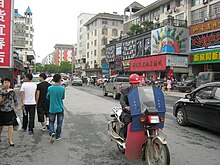Yi–Liu Gan
Appearance
| Yi-Liu | |
|---|---|
| Yichun | |
| Native to | China |
| Region | Central and western Jiangxi |
| Chinese characters | |
| Language codes | |
| ISO 639-3 | None (mis) |
| ISO 639-6 | yilu |
| Glottolog | yili1247 |
| Linguasphere | 79-AAA-faf |
 Map of Gan languages; Yi-Liu-speaking region in yellow. | |

Yi-Liu, sometimes called Yichun (simplified Chinese:
Sounds[edit]
The Yichun variety will be taken as representative.
Consonants[edit]
| Bilabial | Alveolar | Alveolo- palatal |
Post- alveolar |
Velar | Glottal | ||
|---|---|---|---|---|---|---|---|
| Nasal | m | ɲ | ŋ | ||||
| Plosive | aspirated | pʰ | tʰ | kʰ | |||
| unaspirated | p | t | k | ||||
| Affricate | aspirated | tsʰ | tɕʰ | tʃʰ | |||
| unaspirated | ts | tɕ | tʃ | ||||
| Fricative | f | s | ɕ | ʃ | h | ||
| Lateral approximant | l | ||||||
Tones[edit]

| Tone number | Tone name | Tone contour | Examples |
|---|---|---|---|
| 1 | dark level (阴平) | ˨˦ (25) | |
| 2 | light level (阳平) | ˦ (44) | |
| 3 | rising sheng ( |
˧˩ (31) | |
| 4 | light departing ( |
˨˩˧ (213) | |
| 5 | departing sheng ( |
˥ (55) |
References[edit]

